
A Carcassonne Yodel in Blue [Kunsttour 2013]
june 09, 2013.
Right below there's a picture of our 'Carcassonne Table', installed in a small room in the Maastricht Timmerfabriek during the 2010 Kunsttour. The collection of rubbish that it - only barely - holds, is a homologue of the messy set of objects described in Daniel Spoerri's Topographie Anecdotée du hasard. At the opening of the exhibition, all objects were put on the table's top in accordance with the map that is the beating heart of Spoerri's booklet. Sounds produced by their occasional displacement, instigated by the visitors of the installation (who were encouraged to touch anything they liked), were amplified via a series of contact microphones installed inside the tabletop.
That's how it was three years ago.
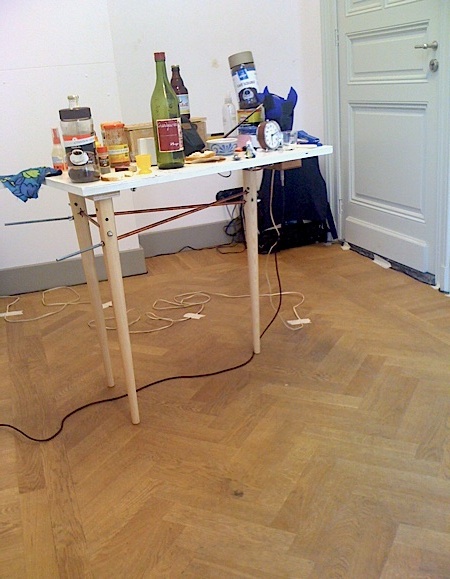
A table history
After Jean-Jacques Duerinckx and myself, supported by the Ateliers Claus in Brussels, had built the Carcassonne table in the early spring of 2010, the curious object became the protagonist of a grand project in 4 parts, three of which - some more, some less - have materialized: an accompanying booklet (made possible by Extrapool and printed by Knust in Nijmegen, the Netherlands); a series of performances and installations in Belgium, the Netherlands and Germany; and (Topographic [Table) Topographique], an ambitious 60+ track studio recording & compositional thing, for which the studio and technical support were provided by the Pianofabriek in Brussels. (The project's fourth part, still unrealized, is a musical 'new reality' play in four acts entitled Looking for Room 13 - A la recherche de la chambre 13.)
Four and thirteen are the Carcassonne Table's 'key numbers', so it should not surprise you that (Topographic [Table) Topographique] is a work in four parts. Each of these parts corresponds to a region of the Carcassonne Table: Northwest, Southwest, Northeast and Southeast. Each region uses an extensive index of recordings of all possible sounds made with the objects on a corresponding part of the table. Structurally and musically (though in a limited and devious sense) the work is based on a distorted projection of what many consider to be the very worst conceptual prog rock album ever to be made by a 1970's high profile act, to which, especially in 2010 and 2011, I was listening over again and again on the endless bus trips that took me up and down between Paris and Amsterdam. (I will let you guess which album I mean :-) The musical heart of (Topographic [Table) Topographique] is provided by the masterly sax playing of Jean-Jacques Duerinckx, who for two long weeks in Brussels blew his very heart and soul out, along with Jacques Foschia on clarinets, Rick Staelens on alto sax, Bart Maris on trumpet, and the Brussels Fanfare Rambo Bambo.
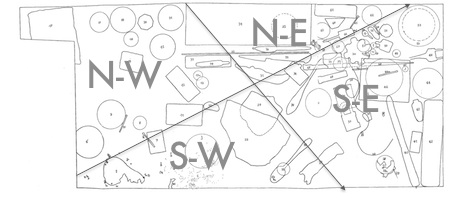
Once all the recordings had been made (in April 2011), it took me several more months of unpaid but full-time work (in 2011 and 2012) to finish the album-to-be. There is quite a long gap between the album's editing (finished at the end of 2011's summer) and its final mix (in January/February 2012), because I then had to urgently write the ULTRA book (which unlike the Carcassonne Table did provide me with an income). Absolutely nothing, btw, will ever suffice to express my gratitude to Sam Vanryssel, the Pianofabriek's sound engineer, and his endless patience in realizing, re-realizing and re-re-realizing in ProTools the thousands of tiny edits and complex layerings of the 'bag full of recordings' that I needed him to execute, following to the letter the detailed schemes in my notebooks. After the final mix, again there were a lot of very different things that had to be done. It is the main reason, that, brilliant and fully finished, (Topographic [Table) Topographique] ended up unheard, sealed and locked away in one of my many drawers. Another reason is, that in view of all the time and work that was invested in its making, however much I want you to hear it, it is not a thing that I am very likely to ever just give away for free.
In April 2011, after we had finished with it for the recordings in the Pianofabriek's studio, Jean-Jacques took the Carcassonne table home with him to Braine L'Alleud, about 20 kilometers south of Brussels. It has been resting there ever since.
Until a couple of weeks ago.
A table invitation
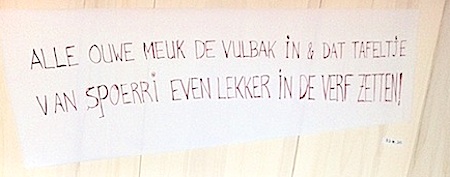
After the final mix of (Topographic [Table) Topographique] early 2012, I gave the Carcassonne table but sadly little further thought. Not because I had lost interest, but because I could not find the necessary time to re-start shopping around for money spending angels, which obviously will be needed for an appropriate physical release of the album or for producing Looking for Room 13. The album I want to feel, sound and look precisely as it should, and it will need someone other than myself to distribute it and make it heard. Without this, I'd rather keep it in my drawer. And the play needs 7 actors and 6 musicians, all of whom of course we would like to properly reward for their investment and time. Not even mentioning the fact that there should be a reasonable number of places to perform the thing, each one providing enough of a fee to at least cover the costs for travel, lodging and food.
Given my current preoccupations, it really came as a surprise when earlier this year I received an email from the Maastricht Kunsttour's artistic director asking me whether I would like to come and show the Spoerri table at the fourteenth edition of this major Maastricht art event. Not that Bert was suddenly offering me a lot of money. Or just a little bit. Nor he nor me ever even mentioned it. But Maastricht is my hometown, and I always very much enjoyed participating in its Kunsttour. I did so every year since 2006, except for the last one. (That was because of the many ULTRA related activities around that time, but maybe even more so because last year's was the Kunsttour's thirteenth edition.)
So, yes of course, I told Bert. Of course I'll be there. And yes, why not bring the Carcassonne table? It was as good a reason as any to start giving it again some thought...
Via Brussels and Amsterdam...
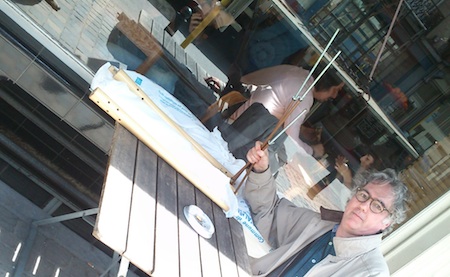
It thus came about that on Wednesday May 15th, on my way for two days of teaching at the Rietveld Academy in Amsterdam, I found myself in Brussels for the first time in over a year. In Café Walvis I met up with Aernoudt Jacobs, who took me to see the exposition of his Overtoon collective at the Imal, and in his studio explained me some of the fascinating art/science constructs that he is working on. Then somewhat later, again at Café Walvis, I saw Jean-Jacques Duerinckx, who, on his way from Braine L'Alleud to a rehearsal, had agreed to make a stop and bring me the Carcassonne table. Bare. Without all the rubbish that we use for its decoration.
Very early on I dismissed the idea to again expose the table in Maastricht the way I did at the 2010 Kunsttour. Unless there is an urgent reason to do so (which may, indeed, be an economic one): never repeat yourself. Altijd nieuw, altijd anders. (I do consider this a credo, not in the least because with the passing of the years it gets harder and harder to hold on to.) For a little while I then toyed with the idea to jump at the occasion to have people listen to (Topographic [Table) Topographique]. In private. For this I wanted to built one, maybe even two or three, sonically isolated listening booths, like the ones I remember from some of the record & hi-fi stores in the 1970s, especially the highbrow ones that specialized in classical music and mainly stocked Deutsche Grammophon and stuff. On the other hand, at least in Maastricht, it was only in these stores (there actually was only one) that you could find the so very adventurous Nonesuch Records series of electronic and 'new music'. I think I remember listening to a lot of Nonesuch in precisely such booths, in Goossens's record store in Maastricht. I'm not completely sure though. Maybe someone can confirm that Goossens indeed had such booths? Until then this may very well be a false memory, that entered my head only because it makes for a good story to accompany an idea. A good idea, but one that I will have to keep for another occasion. I would have needed at least a couple of additional days in Maastricht, and a pile of wood and other materials, to build the booths.
But pretty soon after dismissing the listening booths for purely practical reasons, it became pretty obvious to me what I should do. It even was the best of all possible options, without a shadow of a doubt.
I would paint the Carcassonne table in blue.
... on to Maastricht
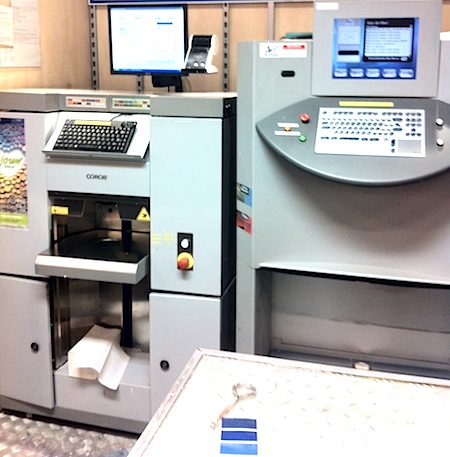
Painting the Carcassonne table in blue was not a joke, though I have made no effort to discourage people from considering it as such. Its may-being a joke ensured that my contribution was nicely covered by this year's Kunsttour theme: 'Is there still something left to laugh about in the arts?'
But, really, no. It was not a joke. It was also not merely some random act. I could not have painted the table in some other color, like red, green or yellow. In fact, from the very beginning, when Jean-Jacques and I built the table in Brussels in 2010, I knew that at some future point in time I would have to paint the table's top in blue. Not that painting it in blue has some sort of a meaning. Most of you will know that I have a profound aversion against things that - from the start, by their makers - are meant to mean something other than what they are. Though you of course are free to give it any f**king meaning you like, for me painting the Carcassonne table in blue means 'painting the Carcassonne table in blue'. And I painted the table in blue, because there was a very good reason to do so. A reason that anybody will be able to uncover by herself (though it will probably take a little bit of (re)search). I think this should do as an explanation, so let me just leave it at that.
On Friday, May 17th, I took the Carcassonne table straight from Amsterdam to the Wiebengahal in Maastricht, which was the central spot of this year's Kunsttour. There, in the fine little corner that had been reserved for me, with a splendid view on and from the street, the Avenue Ceramique, the bare and as yet unpainted Carcassonne table was shown on the Kunsttour's opening night. The next morning, in a local shopping mall, I bought an apron at the Blokker and then went to the Praxis, where I had half a liter of special blue matte paint mixed. I also bought two brushes, a bottle of brush cleaner and some sandpaper. This was all I needed for a first layer of painting. It was also more than enough for a second layer, on the second day. And on the third and final day of this year's Kunsttour, everybody could admire the Carcassonne table in all of its new shiny blueness. Meanwhile, I hung around in the Wiebengahal, telling related and sometimes barely related or even completely unrelated stories, for those of the many visitors that were curious and intrigued enough to ask me questions about it.
It gave me a truly great time.
Wiebengahal, Maastricht. May 18th, 2013
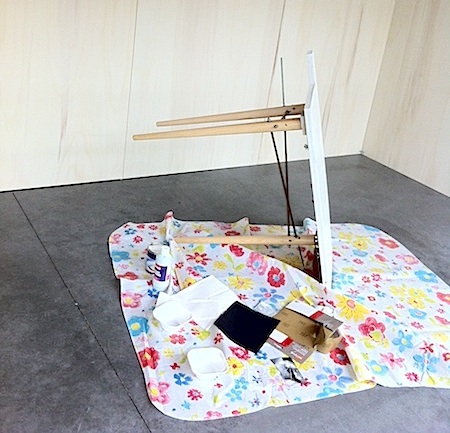
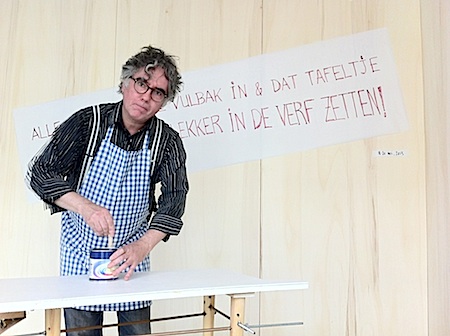
"Doet U ook tafeltjes aan huis, bij mensen?" ("Do you also refurbish tables at people's homes?") [[ * ]]
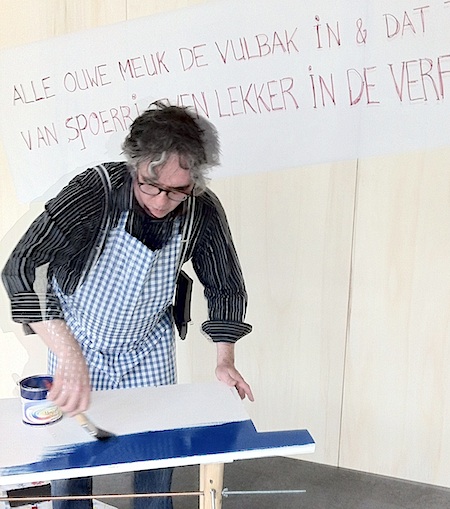
"U heeft wel een héééle mooie kleur blauw uitgezocht!" ("It's a very beautiful kind of blue!") [[ * ]]
Wiebengahal, Maastricht. May 19th, 2013
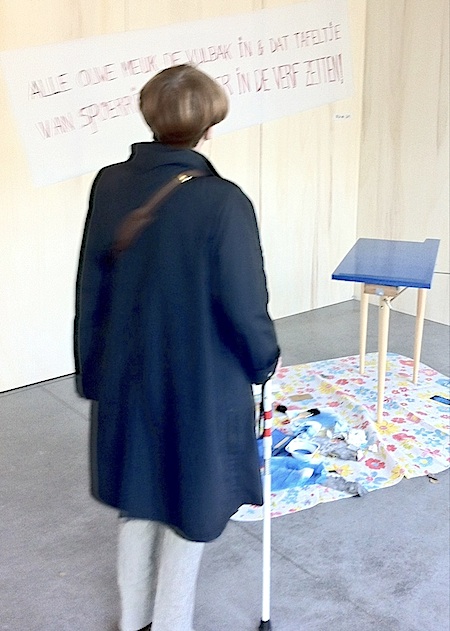
"Laat ik nou toch altijd gedacht hebben dat U aan muziek deed!" ("And I always thought you were a musician!") [[ * ]]
Wiebengahal, Maastricht. May 20th, 2013
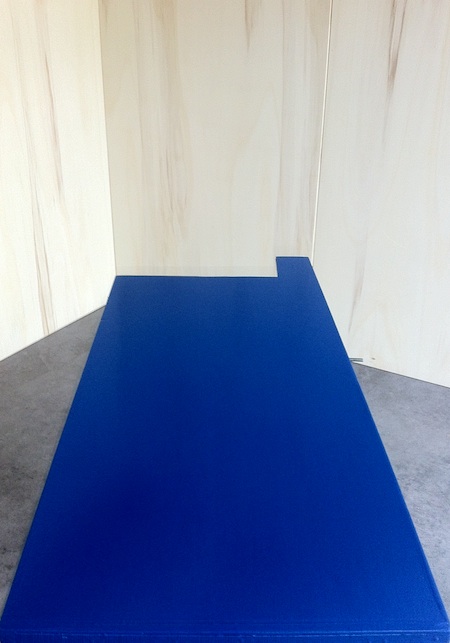
"Da's nou's échte kunst, met een mooi verhaal uit de mond van de kunstenaar zelf!" ("Now that's what I call real art, with a great story straight from the mouth of the artist himself!") [[ * ]]
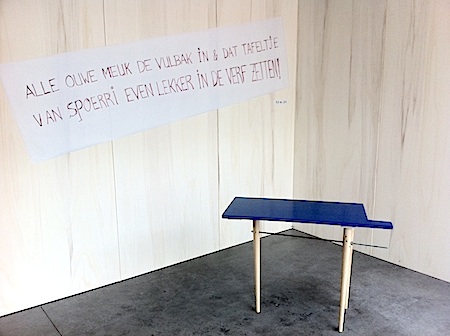
More Kunsttour 2013
There of course was a lot more to be had at the fourteenth edition of the Maastricht Kunsttour. But, as in the other years, participating - and especially busying oneself with handycrafts like sanding and painting - left little time for visiting more than a handful of the some fifty locations that were part of this year's event. I did manage to drop in at some of them, in the mornings, when walking from the Malberg neighborhood in the north western part of town, to the Wiebengahal in the mid east, on the other side of the Meuse.
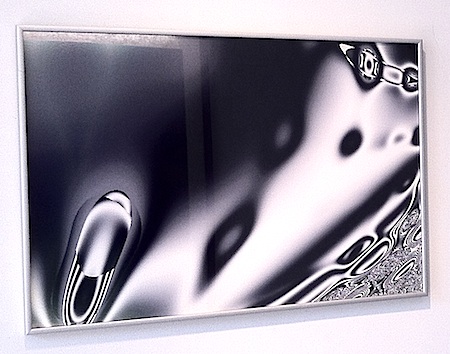
I spent some time at Intro in situ's, which showed a retrospective of the interesting work of Cornelis Paashuis (1941-2004), a Maastricht pioneer of digital art and electronic music, and relaxed for a while in the sunny courtyard of the Landbouwbelang (a longstanding subcultural bastion in the Limburg capital, and one of the too few that are still remaining), which for this Kunsttour was partly taken over by a collective of artists from Antwerp, Belgium.
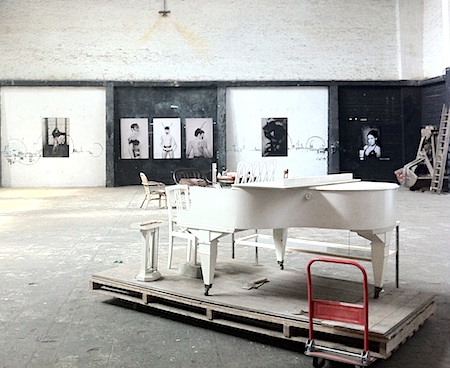
I made one or two quick tours of the Timmerfabriek, which - among too much else to even try to mention - had another couple of fine examples of Wil Peerboom's photo portraits. They were fun and fresh as ever, as well as surprisingly blue...
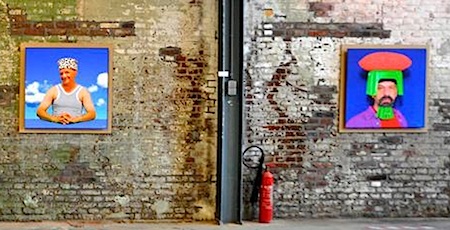
Also in the Wiebengahal, but on the other side of the wall, works by the three nominees for the 2013 Hermine van Bers visual arts price were shown. This year the price - a medal and a little bit of cash - was awarded to Tanja Ritterbex. Rightly so. A couple of times over the weekend I took my break and an umpteenth cup of Coffeelovers coffee around the corner, to have a look at Tanja's paintings. There must have been something about the colors that made me do that.
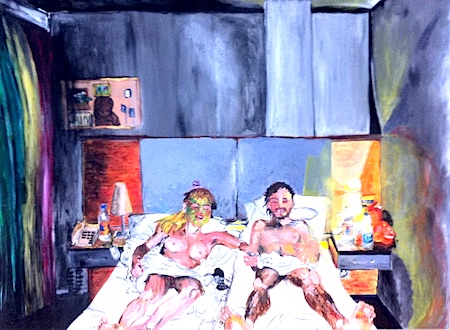
...
tags: Kunsttour, Spoerri, Re: Table, Maastricht
# .437.
comments for "A Carcassonne Yodel in Blue" ::
|
Comments are disabled |